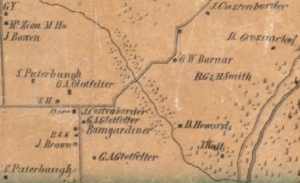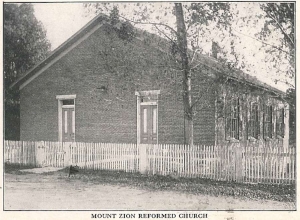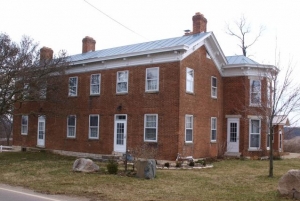Book
Continue north through the intersection. On the right are several farmhouses dating to the late 1800’s. Turn left on Tara Trail E. Beyond the third house is a clearing where you can look north and see the gorgeous Colonial at 2800 Tara Trail, built by Jacob Hanes (previously Haines) Jr. He, his wife Mary (Nesbitt) and their three children loaded into a covered wagon and immigrated to this 430-acre tract of land from West Virginia in 1805 that had been purchased by his father, John on a previous trip.
Jacob, later known as Judge Hanes, held some of the most prominent offices in the county, serving as an associate judge for seven years and a longtime Justice of the peace. He was also a veteran of the War of 1812. He and Mary had seven children including Jonathan ‘Squire’ (local distiller and farmer), Jacob (married Adam Coy’s daughter Susan and had seven children, John N. and Henry being Captains in the Union Army). The family also owned large tracts of land along Hanes Road, not-so ironically. Please return to N. Alpha-Bellbrook Road and turn left.
In the 1970's and 80's, the Parks family hosted a wide array of exotic animals on their acreage that's now part of Tara Estates. Amid the smell of Southern Comfort in the air, reports of a camel, buffalo, peacocks, llama, emu, a yak with a crush on a donkey, ostriches, possibly an ill elephant rescued from a circus and a beer guzzling bull are most prominent!
At the northwest corner of this intersection stands a home that was formerly Benham School #4. The original structure is still intact and can clearly be seen in the current residence at the location.
 Benham School #4 As A Residence
Benham School #4 As A Residence
Benham School #4 As A Residence
Benham School #4 As A Residence
 Benham School #4 As A Residence
Benham School #4 As A Residence
Benham School #4 As A Residence
Benham School #4 As A Residence
https://beavercreekliving.com/book/itemlist/user/23-brettwilliford?start=110#sigProId05f9b6028a
As you reach the intersection at Swigart Road, two generations of the Bumbardner family operated a blacksmith shop at the corner. The older homes in this area all c. 1900. Turn right. The 187 acre Jonathan Snyder farm encompassed much of the land on the north side of the road to Indian Ripple Road. In 1841, Jonathan operated the original distillery in the town of Trebein, which was later owned by F.C. Trebein.
Continue around the curve and beyond Sperling Lane to the intersection at Indian Ripple Road.
As you continue south, pass through the stop sign at Swigart Road. You’re now on land that in the early 1800’s was the 250 acre farm of Samuel Puterbaugh, you’ll find his beautiful home at 407 South Fairfield Road.
Please turn left onto Stutsman Road and left again onto South Alpha Bellbrook Road.
At the intersection of North Fairfield and Indian Ripple Roads stands the former Mount Zion church and cemetery as well as the Mt. Zion Park Cemetery. Mt. Zion was a Reformed Church connected to both Beaver and Hawker churches. In 1845, 60 members of Beaver Church formed a separate congregation and formed Mt. Zion. The land for Mt. Zion Park Cemetery was donated to the public by Benjamin Darst as a then free burying ground.
Indian Ripple Road was re-routed in the early 2000’s, removing the jog around the retaining wall that seemed to attract the front ends of many American muscle cars.
https://beavercreekliving.com/book/itemlist/user/23-brettwilliford?start=110#sigProId2f20f193a0
The home at 619 N. Fairfield Road dates to 1896 and was built for C. Coy.
After cresting the hill heading south on North Fairfield Road, you‘ll find the farms of Daniel and Moses Shoup on the west. Just beyond Fairbrook Elementary school is the Shoup-Durnbaugh House located at 182 North Fairfield Road. Originally built by Moses Shoup, a prominent farmer and 50-year German Baptist minister, in 1820.
Later it became known by another locally famous owner, son-in-law Benjamin F. Darst. Benjamin served as a Lieutenant and Captain in the Civil War. Son of Benjamin and Rebecca (Shoup), Harry was a prominent local banker who entertained graciously in the house until his death in 1962. The home has been lovingly restored by John & Brenda Durnbaugh since their purchase in 1982.
https://beavercreekliving.com/book/itemlist/user/23-brettwilliford?start=110#sigProIde88f5f1d55
Jacob Sr. sold much of his land to his children and their spouses for $1 per tract. He donated land for the first schoolhouse in Greene County, estimated to be near the intersection of Homeway and Towncrest Drives. This school was taught by a very eccentric English gentleman, who prided himself on a rich sounding name and an imaginary title – insisting, on all occasions, on being addressed as Thomas Marks Davis, the Second. He succeeded in supporting the dignity of the title on a very uncertain salary, fluctuating between eight and ten dollars per month.
In the image above, Jill Kincer of the Beavercreek Historical Society presents a foundation stone from Greene County's first school to be incorporated into the construction of BCSD's new pre-school adjacent to the Board of Education building. Several of the stones were also used as the base around the main informational marker at Wartinger Park in 2015.
Jacob Coy and his sons and sons-in-law were instrumental in the clearing of land and opening up Beavercreek for farming, several of them incorporating granite-carved timber into their burial markers.
Heading south on North Fairfield Road, through Apple Valley, brings you into the 3,000 acres (4.6 square miles!) of the Coy family, its patriarch Jacob emigrating to America in 1757 and settling in the Beavercreek area after several of his children had grown and married. The log home they constructed in 1827 was moved and preserved and still stands in Beavercreek today near the Hagenbuch residence as previously described. The home originally stood southeast of Kirkmont Church on the Coy Homestead, while Coy cemetery is located adjacent to the west side North Fairfield Road just south of the Shakertown intersection.
The configuration of Shakertown Road in the image above has changed, but you can get a small glimpse of the reach of the Coy family. Many of the Coy descendants married and stayed locally, and the Coy name is prevalent throughout the township!
Here is a biography of Jacob Coy, Jr., believed written in 1888:
Jacob Coy, retired farmer, Alpha, is the oldest living settler in this township. He was born in Frederick County, Maryland, in 1792, being a son of Jacob and Susana Coy, who were born in Germany. They, with their parents, came to America when yet young, and while on the voyage, Jacob's parents died and were buried in mid-ocean. Their effects were confiscated by the ship's crew, and their children, seven in number, were thrown upon the shores of a new world penniless, in consequence of which they were sold to pay transportation. He (Jacob) was eighteen years old at the time, and labored six years for a Pennsylvania planter to free himself and younger brothers and sisters. He afterwards located in Maryland, where he was married, and lived a number of years, accumulating three hundred and fifty acres of land. When married he borrowed the money to cover necessary expenses. In 1800 be immigrated to Ohio, coming down the river to Cincinnati, where he stopped two months. Then there were only sixteen low log cabins in the place. He was importuned to stay, but pushed his way by team and wagon to Greene County; their way was cut through the woods in advance of the teams, and were eight days in coming. He purchased three thousand acres of land, all in a body, and erected a small log cabin, into which he moved his family. Two kegs of nails used in the erection of the cabin, were brought from Cincinnati on horseback, by young Jacob, our subject, for which twelve and one-half cents per pound were paid. Here Jacob Coy, Sen., lived and died, his death occurring in 1835 or 1836, at the age of ninety-three years. His wife died about 1840, aged eighty-three years. They were parents of twelve children, all dead except Jacob, who was the youngest. They were members of the German Reformed Church of many years standing. Jacob was eight years old when his parents landed in Ohio, and distinctly remembers counting the houses in Cincinnati, and says he has gathered hazelnuts where the city of Dayton stands. He has seen many hardships, and often working till midnight in burning brush; he has hauled flour from Cincinnati for $2.50 per barrel; wheat was sold for twenty-five cents per bushel, corn ten cents, coffee seventy-five cents per pound, and of the latter, three or four pounds did an ordinary family a year. He labored on the farm for his father till of age, when he began life for himself, but remained with his aged parents, to whom he was much attached, caring for then while they lived. On the old home farm he has lived four score years, and witnessed all the great changes that have transformed the wilderness to a garden of peace and plenty. In 1813 he was married to Barbara, daughter of Leonard Snypp, who bore him twelve children, five living; Peter, Henry, Adam, Leonard, and Susana. The deceased were, Rebecca, Catherine, Sarah, Jacob, David, Anna, and an infant. Mrs. Coy died in 1859 or 1860. Both were members of the German Reformed Church, having joined after their marriage. He has served as elder and deacon for twenty years. In politics he is a Republican, and during his long life has failed but once to cast his ballot for the benefit of that party.
Learn more about Jacob and his descendants on this family geneaology page. There's a lot of great information with the links on the page.
Follow E. Patterson Road through more of what was John Moler’s land and veer right onto Research Boulevard, then right onto Seajay Drive. This 112 acre area was once owned by S. Kable, whose family raised beef cattle, dairy cows and hogs. They would drive the beef cattle into Dayton to be sold and deliver milk into Dayton via the Traction.
Beaver Valley shopping center is home to the ‘New’ Lofino’s Grocery as well as other retailers and restaurants.
https://beavercreekliving.com/book/itemlist/user/23-brettwilliford?start=110#sigProIda2fd32cef6
Turn right onto Patterson Road. Both homes at 3927 and 3928 E. Patterson Road date to c.1900 and were on Shoup land. On the right at 3827 E. Patterson Road is the Daniel Shoup House. This Vernacular style all-brick home was started in 1857 by Solomon Shoup and completed by his son Daniel in 1858.
The home and 200 acres were assumed later by Arthur Shoup, Daniel’s son, who was a progressive farmer for his day; incorporating crop rotation. He was the first dairy farmer in the area to employ an automatic milking machine. Unlike his father and grandfather, he did not pursue the tradition of being a minister in the German Reformed (Dunkard) Church.
Navigation
Latest Blog Posts
- Just Don't Call Us Late For Dinner...
- Remember When...
- What A Long, Strange Trip It's Been...
- Snow Down = Slow Down
- School Bus Safety - Just Do It!
- Stevenson Road Covered Bridge
- Our Road Crews Are Worth Their Salt!
- The Most Colorful Of Seasons!
- Popcorn Fest! - Then And Now
- Pre-School Paradise!
- Remembering Riffles
- Ten Year Anniversary Of The Beaver Statues














